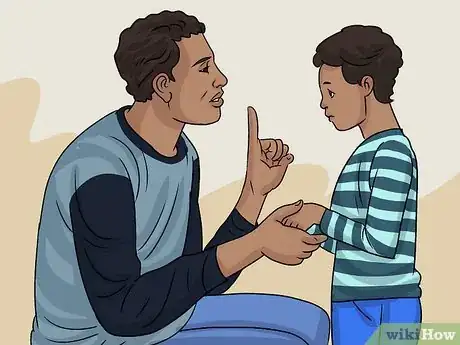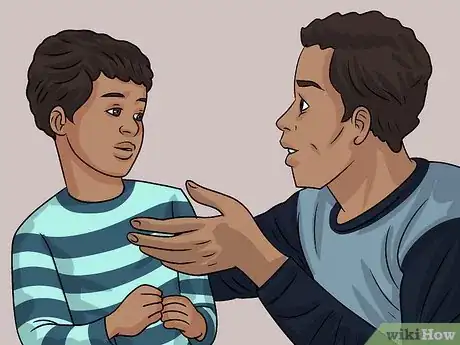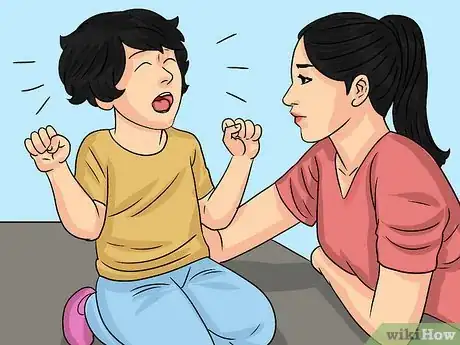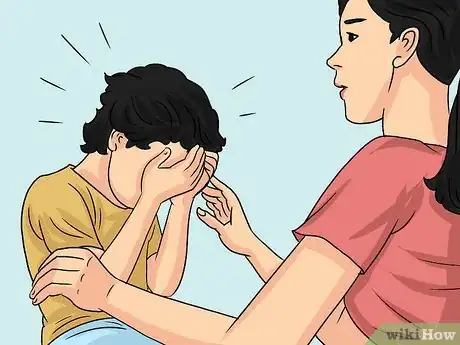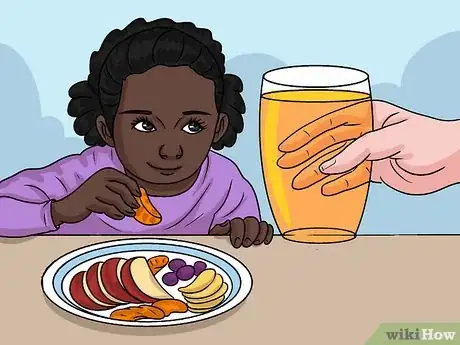This article was co-authored by Trudi Griffin, LPC, MS. Trudi Griffin is a Licensed Professional Counselor in Wisconsin specializing in Addictions and Mental Health. She provides therapy to people who struggle with addictions, mental health, and trauma in community health settings and private practice. She received her MS in Clinical Mental Health Counseling from Marquette University in 2011.
This article has been viewed 258,812 times.
When children are unruly it can be stressful for their parents and caregivers – and an indication that the child is upset, fearful, or confused. Handling an unruly child takes some skill and strategy, but you can work together with the child so that she can learn better self-control and you can both feel more calm more often. Remember that it is the child’s behavior that is the problem – not the child. Be sure that unruly children feel aware that you love them and that you see them in a positive light despite their disruptive behavior. You should never hit or spank a child, and you should never shake or hit a baby in any way.
Steps
Creating Order Out of Chaotic Behavior
-
1Create a set of family rules. Your first priority should be to create rules around the behaviors that are causing the most disruption or have potential risk for harm. If you are the main caregiver for the child, you can develop the rules on your own. If your child spends a great deal of time with another caregiver (another parent, grandparent, or paid caregiver), then work with that person on the rules.
- Make sure that the rules you develop are clear and simple. For example, for a child who has trouble with physical aggression, the rule could simply be worded “no hitting.”
-
2Give your child alternatives to bad behavior. Children need help replacing an undesirable behavior with something new that will help them learn to control themselves. Depending on what behaviors you are working on, you can try one or more different alternatives.
- Stop, think, choose. Stop the current activity, reflect on what you are thinking, and then consider consequences for yourself and others before you choose your next action.
- Personal time-out. Leave the room and take a few minutes to calm down before you return to the situation.
- Talk about how you feel. Tell a person you trust about how you are feeling by naming the feelings you are having and how the feelings are affecting you.
- Deep breaths. Take several deep breaths to help you if you are overwhelmed by feelings.
Advertisement -
3Define meaningful rewards and consequences. Put meaningful rewards in place for when the child follows the rules. The consequences you choose should be minor and should not involve spanking or hitting the child. Consequences should also be age-appropriate.
- Positive reinforcement of good behavior is very powerful. Meaningful rewards don’t need to be expensive toys or outings. Spending time with a child playing a game she enjoys might be a very inspiring reward for a child. And praise from you is a very meaningful reward for every child.
- When it comes to consequences, keep them minor. For older children, docking allowance or assigning an additional chore might be effective. For younger children, a brief time-out (no more than one minute for each year of the child’s age) would be more appropriate.
-
4Take the time you and your child need to discuss the rules together. You do not want the child to have any confusion about what the rules mean or what “counts” as breaking the rules. Focus on what you want the child to do instead of the bad behavior.
- For example, tell your child that instead of hitting someone, you would like him to come to see you and tell you about feeling angry.
- Try role-playing with your child using “real-life” situations you have the child become upset and exhibit the bad behavior.
-
5Model the behaviors you want to see in your child. One way to help children understand how to behave is to show them by example. If you and your child have agreed that the best way to avoid hitting is to take a few minutes alone to calm down, then you can try doing this yourself in front of your child.
-
6Consistently enforce the rules right away. If your child breaks a rule, always use the consequence, and move to the consequence right away. If you wait until later or only enforce the rule sometimes, you are much less likely to see a behavioral change in your child. Similarly, when children follow the rules by using the replacement behavior you have worked on together, you should make sure to reward and praise them immediately.
- Parents who do not enforce the rules consistently and quickly tend not to see change in their child.
-
7Communicate with all caregivers about the rules. If your child spends weekends with another parent or after-schools with a caregiver, then communicate with that person about the system you have created with the child. Consistency across settings will help your child be more successful.
Getting Through a Temper Tantrum
-
1Know the facts. Temper tantrums are normal, especially in young children. They can last for a few minutes or for hours and can be stressful for the child and the caregiver. A child having a tantrum might scream, yell, and cry, but might also roll around on the floor, run around the house, or pound on the wall with fists.
- Temper tantrums can be caused by all sorts of things, from being tired or hungry to not knowing what words to use or having trouble doing something difficult.[1]
-
2Stay calm when a tantrum starts. When your child does get into a tantrum, it’s important for you to stay calm. If you become upset, that will make the situation worse for both of you. Know that tantrums are common among children and that this will pass.[2]
-
3Don’t give in and don’t argue or yell. Don’t give in to what the child wants. Doing so will teach your child that tantrums work, when what the child needs is to learn is how to recognize and express the feelings he is having. Arguing and yelling will not work either. Even though it can be frustrating to be around a child’s tantrum, arguing and yelling just create a power struggle. Being calm is best.[3]
-
4Make sure your child doesn’t get hurt. When children, especially young children, have a tantrum, they can sometimes put themselves in danger. Make sure that your child is not going to hurt herself during the tantrum. Keep a close eye on the child.[4]
- Make sure no one else gets hurt by the tantrum behavior, such as another child nearby.
-
5Try talking calmly to the child. If the child is old enough to understand, then move over close to the child and calmly explain what you want the child to stop doing and how you would like the child to replace the negative behavior.[5]
-
6Move child to a safe quiet place. If your child doesn’t seem to be able to stop, then you can move the child to a quiet calm space and tell the child to be quiet for one minute. Once the child has achieved one minute of silence, end the time out period.[6]
-
7Show your love when the tantrum is over. It is important for children to feel loved after they have had a tantrum. Stay calm and express your love for the child, while also praising the child for stopping the tantrum.[7]
- Remove whatever was causing the tantrum and give the child something easy to do. For example, if the tantrum came about after the child tried to color a difficult picture, remove that picture and choose something easier for the child to work on.[8]
-
8Prevent tantrums at home. Learn about what situations cause your child to have a tantrum, and spend time with your child talking about how to recognize emotions. Be sure your child has toys that are age-appropriate, and keep meal and sleep times regular each day.[9]
- You can also talk with your child about expressing feelings through words or by letting out upset energy in a more positive way.
-
9Prevent tantrums away from home. If your child is prone to a tantrum when you are out, then don’t go out if your child is tired. Be sure that you have snacks with you as well. Include the child in what you are doing by talking with the child about what is happening. Help the child feel that he is participating actively in what you are doing – even if it is standing in a long lineup at the bank.[10]
Dealing with Someone Else's Unruly Children
-
1Be prepared by talking with the child’s primary caregivers. Children, especially children five years old and under, are not always able to control their feelings or behaviours. Be prepared for misbehaving and meltdowns, and talk with the child’s primary caregivers (for example, a parent) about what to avoid, what rules the children are accustomed to, and how you should enforce the rules when their usual caregivers are not there.
- It is important for children to have rules enforced consistently by everyone who takes care of them, including you. Find out what rules the child is expected to follow and how the parents would like you to handle breaking any rules.[11]
-
2Don’t try to be a “parent.” Even if you might prefer to do things a little bit differently than a child’s parents do, you should follow their rules anyway. Children need to hear consistent messages about what is expected of them, and they need to see consistent outcomes when they break the rules. Otherwise, they become confused and will actually misbehave more often.
- ”Giving in” to a child’s demands, including things like eating too much candy or not going to bed on time, can upset parents and confuse children. Children might seem to respond positively to your permissiveness in the beginning, but their behavior will go downhill quickly if you don’t use good boundaries based on parents’ guidelines.[12]
-
3Keep children busy with engaging activities. Boredom is a common cause of misbehavior, so if you are taking care of children for someone else, be sure to spend time with them doing something fun and interesting. Keep children busy and they are less likely to become unruly.[13]
- If you can, find out in advance what the child enjoys doing. Arts and crafts projects, games, or playing with favorite toys can all be engaging activities for children.
-
4Keep children from being hungry and tired. Hunger and tiredness can also be the root cause of unruly behavior. Make sure you have appropriate snacks and meals on hand, and that you know nap schedules for younger children. Children behave better when they have had enough to eat and go to bed on time.[14]
-
5Stay calm and use positive discipline. If a child misbehaves, it is very important for you to stay calm, then to bend down so that you are on the child’s level. Tell the child – calmly – what is wrong with their behavior. Then tell the child what you would like them to do instead. Remember to use the rules and consequences you have discussed with the child’s parent(s).[15]
- Never raise your voice or hit a child. Never shake or hit a baby in any way.
-
6Distract and comfort a child who is very upset. If the child is beyond being reasoned with, then distraction and comfort are your next options. Hugs, favorite toys, teddy bears, snacks, or new activities are all things that you can try to help the child feel better.[16]
Warnings
- If you are babysitting, never hit or spank a child. Ask the child’s primary caregivers (parents or other guardians) how they would like you to help with their methods for disciplining their child.⧼thumbs_response⧽
- Never try to discipline a baby. Never shake or hit a baby. When a baby cries, it is a signal that the baby needs your attention, so go to the baby and see what you can do to provide comfort.⧼thumbs_response⧽
- Never hit or spank a child. There is a large body of evidence suggesting that physical discipline methods have negative effects and are ineffective. Hitting or spanking a child can cause serious physical and psychological damage.⧼thumbs_response⧽
References
- ↑ http://www.gov.mb.ca/health/documents/temper.pdf
- ↑ http://www.gov.mb.ca/health/documents/temper.pdf
- ↑ http://www.sagepub.com/sites/default/files/upm-binaries/26242_Appelbaum_Preschoolers_Chapter_1.pdf
- ↑ http://www.gov.mb.ca/health/documents/temper.pdf
- ↑ http://www.gov.mb.ca/health/documents/temper.pdf
- ↑ http://www.gov.mb.ca/health/documents/temper.pdf
- ↑ http://www.gov.mb.ca/health/documents/temper.pdf
- ↑ http://www.gov.mb.ca/health/documents/temper.pdf
- ↑ http://www.gov.mb.ca/health/documents/temper.pdf
- ↑ http://www.gov.mb.ca/health/documents/temper.pdf
- ↑ http://www.grandparents.com/grandkids/discipline-and-behavior/how-to-handle-meltdowns
- ↑ http://www.helpguide.org/articles/grandparenting/how-to-be-a-better-grandparent.htm
- ↑ http://www.teachkidshow.com/teach-your-child-to-behave-with-a-babysitter/
- ↑ http://www.urbansitter.com/blog/how-to-respond-when-a-child-misbehaves/
- ↑ http://www.urbansitter.com/blog/how-to-respond-when-a-child-misbehaves/
- ↑ http://www.grandparents.com/grandkids/discipline-and-behavior/how-to-handle-meltdowns
